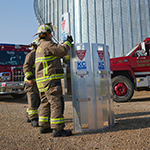Grain bin anchors
Grain bin anchors serve a key role in preventing grain bin entrapments for grain handlers who must enter a grain storage structure.
Farmers, grain elevator workers and other grain handlers are exposed to suffocation or engulfment hazards when they enter a grain bin to break up bridged or crusted grain or perform maintenance.
Even though most grain handlers are aware of the dangers and safety protocols, many still improperly enter grain bins and “walk the grain” without the necessary safety equipment that’s required for commercial operations.
The following is a slightly edited excerpt from Grain Bin Anchors: Suitable Designs for Use in Grain Entrapment Prevention Systems by Wayne Bauer.
Grain bin entrapments can be averted if grain handlers adopt standard operating procedures before allowing anyone to enter a grain storage structure. These procedures must include locking out the power to the unloading equipment, attaching to an effective anchor point that is managed by a second person and having a written emergency action plan that will be employed if the system fails.
Grain bin anchors, the foundation of any Grain Entrapment Prevention System (GEPS), serve a key role in preventing grain bin entrapments for grain handlers who – after exhausting all other options — must enter a grain storage structure.
We normally speak of two distinct anchor points with a GEPS:
- Peak anchors — located above the entrant
- Side anchors — located at or near the bin entrance
Both are equally important, but we stress the need for future anchor points to be located above the entrant. A rope through the side-access door does little in terms of preventing the entrant from potentially sinking below his waist in the grain. It may be helpful in minimizing the slack in the bin-entry-lifeline, but little else. Peak anchors are designed to support at least 2,000 pounds and line slack should be limited to 12-18 inches.
Other GEPS components include a full-body harness and a properly secured lifeline.
Secured lifeline
A properly secured lifeline must be used for grain bin entry when walking on a sufficient volume of grain that could potentially entrap and/or engulf you or another worker.
According to the Safety and Technical Rescue Association (SATRA), lifelines must be attached to a substantial or “bomb-proof” anchor.
You should never be tempted to attach lifelines to anchors not suitable for life-safety use. Anchors must be able to handle both the static (while working) and the impact (loading system with less than two feet of slack load) during entry into a grain bin. You need a substantial anchor that will handle a variety of loads depending on the application within your GEPS.
The following should never be used as anchor points:
- Handrails
- Ladder rungs
- Electrical conduit
- Aeration ducts
- Spouting
Identifying anchor points
Dr. Carol Jones with the engineering group at Oklahoma State University recommends walking through every facility to identify appropriate anchor points. Jones suggests painting main line anchor points red and belay line anchor points blue, a concept developed jointly by Steve Queen and Bill Harp.
“This is also a great time to have your local fire department and rescue team accompany you on the walk through, says Jones. Any prior knowledge of a facility increases the effectiveness of their response to an entrapment.”
Load requirements
The load requirements on the anchors will vary depending upon some of the following factors:
- How many entrants and/or rescuers are tied into the GEPS? What is the total combined weight of these people?
- Is an anchor located at the peak of the bin or near the side access door?
- What is the angle of the secured lifeline, in relation to the entrant and anchor?
- What is the volume, slope and condition of the grain the entrant is walking on?
- What is the diameter of the bin?
- How far is the entrant from the anchor?
- What is a critical angle? How does this affect some of the issues above?
According to SATRA, loads increase dramatically as the angle of your line increases from 45° to 90° to 135° when directed through a pulley at the peak of the bin.
Currently, the American Society of Agricultural and Biological Engineering (ASABE) and steel bin manufacturers are reviewing minimum load requirements for anchors. The focus target is to have a minimum load requirement of 2,000 pounds.
New bins vs. old bins
In recent years, bin roof design and peak loads have changed dramatically. Roof peak load strengths of 50,000-plus pounds and 20 to 30 psf ground snow loads are available today, along with enhanced stiffener designs and sidewall strengths.
It’s not practical to retrofit the 700,000 to 800,000 steel bins that have been built since 1908, many with non-structured roofs. However, this does not mean that older bins will not support a peak anchor. Ideally, the lifeline should be anchored above the entrant to work effectively. Users of these structures should consult with their bin manufacturer, dealer or knowledgeable engineer for assistance with designing an appropriate anchor system.
Conclusion
Make sure your workers know how to use these systems effectively. Follow accepted best management practices mdash; and don’t take short cuts. It could cost you or someone you love their life.
Additional information on securing lifelines is courtesy of the Grain Handling & Safety Coalition (GHSC).

 >
>

 >
>
 >
>